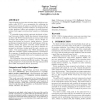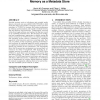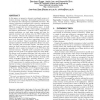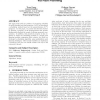128
click to vote
EMSOFT
2006
Springer
15 years 2 months ago
2006
Springer
Distributed real-time and embedded (DRE) systems have stringent constraints on timeliness and other properties whose assurance is crucial to correct system behavior. Formal tools ...
115
Voted
EMSOFT
2006
Springer
15 years 4 months ago
2006
Springer
Upper bounds on worst-case execution times, which are commonly called WCET, are a prerequisite for validating the temporal correctness of tasks in a real-time system. Due to the e...
120
Voted
EMSOFT
2006
Springer
15 years 4 months ago
2006
Springer
Portable systems such as cell phones and portable media players commonly use non-volatile RAM (NVRAM) to hold all of their data and metadata, and larger systems can store metadata...
112
Voted
EMSOFT
2006
Springer
15 years 4 months ago
2006
Springer
We designed and implemented a new programming language called Hierarchical Timing Language (HTL) for hard realtime systems. Critical timing constraints are specified within the la...
117
Voted
EMSOFT
2006
Springer
15 years 4 months ago
2006
Springer
We report on a case study in which the model checker Uppaal is used to formally model parts of Zeroconf, a protocol for dynamic configuration of IPv4 link-local addresses that has...
95
Voted
EMSOFT
2006
Springer
15 years 4 months ago
2006
Springer
87
Voted
EMSOFT
2006
Springer
15 years 4 months ago
2006
Springer
Embedded systems are complex as a whole but consist of smaller independent modules minimally interacting with each other. This structure makes embedded systems amenable to composi...
116
Voted
EMSOFT
2006
Springer
15 years 4 months ago
2006
Springer
Embedded applications like video decoding, video streaming and those in the network domain, typically have a Quality of Service (QoS) requirement which needs to be met. Apart from...
96
Voted
EMSOFT
2006
Springer
15 years 4 months ago
2006
Springer
The paper deals with the problem of computing schedules for multi-threaded real-time programs. In [14] we introduced a scheduling method based on the geometrization of PV programs...





